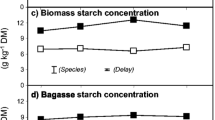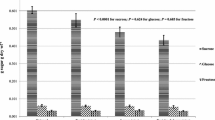Abstract
This research was carried out to evaluate the production and quality of sweet sorghum juice produced in Brazilian semi-arid region, identifying the best spatial arrangements and varieties for this goal. Two agricultural cycles (years 2015 and 2016) were carried out, in a sandy-loam Planosol under rainfed conditions. We assessed BRS 506 and SF-15 varieties, with row spacing (50, 60, 70 and 80 cm) and plant spacing (8, 12 and 16 cm) evaluated in a randomised complete block design with four replications in a triple factorial scheme. During the first cycle, BRS 506 presented mean values of 12.01 m3 ha−1, 23.86 kg ha−1, 16.88 °Brix, 140.02 g L−1 and 4,157.85 L ha−1 for juice yield and weight, total soluble solids content, total soluble carbohydrates and ethanol production. Even during the second cycle, under low rainfall, BRS 506 presented good juice production with proper quality, thus being drought tolerant. Our results showed that the smallest row spacing favoured the variables studied, and the sweet sorghum, cv. BRS 506, is indicated for ethanol production under Brazilian semi-arid conditions, at a spacing of 50 cm between rows and 8 cm between plants. We proved this crop is, therefore, a viable alternative for cultivation during sugar cane off-season in semi-arid regions.

Source: FUNCEME (www.funceme.br) R: accumulated monthly rainfall. T(9 h) = T(09:00); T(15) = T(15:00); RH(9 h) = RH(09:00); RH(15 h) = RH(15:00)


Similar content being viewed by others
References
Albuquerque, C.J.B., F.D. Parrella, R.A.C. Guimarães, A.S. Oliveira, R.M. Silva, and K.M. Jesus. 2012. Sweet sorghum in different row spacing and plant densities in Minas Gerais State, Brazil. Revista Brasileira de Milho e Sorgo 11: 79–95.
Almodares, A., and M.R. Hadi. 2009. Production of bioethanol from sweet sorghum: A review. African Journal of Agricultural Research 4: 772–780.
Alvares, C.A., J.L. Stape, P.C. Sentelhas, J.L.M. Gonçalves, and G. Sparovek. 2014. Köppen’s Climate classification map for Brazil. Meteorologische Zeitschrift 22: 711–728.
Cifuentes, R., R. Bressani, and C. Rolz. 2014. The potential of sweet sorghum as a source of ethanol and protein. Energy for Sustainable Development 21: 13–19.
Costa, A.F., L.S. Vale, A.B. Oliveira, J.F. Brito Neto, W.S. Ribeiro, and G.D. Cardoso. 2017. Evaluation of yield performance in cowpea genotypes (Vigna unguiculata (L.) Walp.). Australian Journal of Crop Science 11: 308–312.
Dalvi, U.S., U.D. Chavan, M.S. Shinde, and S.R. Gadakh. 2012. Effect of staggered planting on stalk yield, sugar content and ethanol yield of sweet sorghum for increasing harvest window. Sugar Tech 14: 144–147.
Dubois, M., K.A. Gilles, J.K. Hamilton, P.A. Rebers, and F. Smith. 1956. Colorimetric method for determination of sugars and related substances. Analytical Chemistry 28: 350–356.
Emygdio, B.M., A.P.S. Afonso, A.C.B. Oliveira, R. Parrella, R.E. Schaffert, and A. May. 2011. Desempenho de Cultivares de Sorgo Sacarino para a Produção de Etanol sob Diferentes Densidades de Plantas–Boletim de pesquisa e desenvolvimento. Pelotas: Embrapa Clima Temperado.
Estatcamp. Software Action. 2014. http://www.estatcamp/empresa/software-action. Accessed November 16, 2017.
Ferreira, D.F. 2011. Sisvar: A computer statistical analysis system. Ciência e Agrotecnologia 35: 1039–1042.
Ministry Of Mines And Energy—Brazil (Ministério de Minas e Energia). Brazilian government establishes the addtion of 27% of ethanol to the gas. 2015. http://www.brasil.gov.br/economia-e-emprego/2015/03/adicao-de-27-de-etanol-na-gasolina-e-estabelecida-pelo-governo. Accessed March 16th 2018.
Nunes, R.L.C., A.B. Oliveira, and A.S. Dutra. 2014. Agronomic performance of onion hybrids in Baraúna, in the semi-arid region of Brazil. Revista Ciência Agronômica 45: 606–611.
Oliveira, A.B. 2018. Sugarcane–Technology and research. London: InTechOpen Publisher.
Oliveira, A.B., E. Gomes-Filho, J. Enéas-Filho, J.T. Prisco, and N.L.M.A. Alencar. 2012. Seed priming effects on growth, lipid peroxidation, and activity of ROS scavenging enzymes in NaCl-stressed sorghum seedlings from aged seeds. Journal of Plant Interactions 7: 151–159.
Oliveira, A.B., J.F. Brito Neto, G.D. Cardoso, and L.S. Vale. 2017. Growth and yield of castor bean (Ricinus communis L.) cv. BRS Energia under different spacings. Tropical and Subtropical Agroecosystems 20: 289–295.
Pereira-Filho, I.A., R.C. Parrella, J.A.A. Moreira, A. May, V.F. Souza, and J.C. Cruz. 2013. Avaliação de cultivares de sorgo sacarino [Sorghum bicolor (L.) Moench] em diferentes densidades de semeadura visando a características importantes na produção de etanol. Revista Brasileita de Milho e Sorgo 12: 118–127.
Rao, S.S., J.V. Patil, P.V.V. Prasad, D.C.S. Reddy, J.S. Mishra, A.V. Umakanth, B.V.S. Reddy, and A.A. Kumar. 2013. Sweet sorghum planting effects on stalk yield and sugar quality in semi-arid tropical environment. Agronomy Journal 105: 1458–1465.
Ratnavathi, C.V., S. Chakravarthy, V. Komala, U. Chavan, and J. Patil. 2011. Sweet sorghum as feedstock for biofuel production: A review. Sugar Tech 13: 399–407.
Ratnavathi, C.V., K. Suresh, B.S. Vijaykumar, M. Pallavi, V.V. Komala, and N. Seetharama. 2010. Study on genotypic variation for ethanol production from sweet sorghum juice. Biomass and Bioenergy 34: 947–952.
Sakellariou-Makrantonaki, M., D. Papalexis, N. Nakos, and I.K. Kalavrouziotis. 2007. Effect of modern irrigation methods on growth and energy production of sweet sorghum (var. Keller) on a dry year in Central Greece. Agricultural Water Management 90: 181–189.
Silva, F.A.S., and C.A.V. Azevedo. 2016. The Assistat Software Version 7.7 and its use in the analysis of experimental data. African Journal of Agricultural Research 11: 3733–3740.
Silva, J.M.F., A.S. Dutra, F.T. Camara, A.A. Pinto, and F.E. Silva. 2017a. Row spacing, plant density, sowing and harvest times for sweet sorghum. Pesquisa Agropecuária Tropical 47: 408–415.
Silva, T.M., M.F.Q. Lopes, A.B. Oliveira, A.L.S.P. Nogueira, I.E.T. Viana, and B.F.T. Lessa. 2017b. Physiological quality of sweet sorghum [Sorghum bicolor (L.) Moench.] seeds in response to planting density in semi-arid region. Australian Journal of Crop Science 11: 694–700.
Souza, R., I. Teixeira, E. Reis, and A. Silva. 2016. Soybean morphophysiology and yield response to seeding systems and plant populations. Chilean Journal of Agricultural Research 76: 1–8.
Teetor, V.H., D.V. Duclos, E.T. Wittenberg, K.M. Young, J. Chawhuaymak, and M.R. Riley. 2011. Effects of planting date on sugar and ethanol yield of sweet sorghum grown in Arizona. Industrial Crops and Products 34: 1293–1300.
Funding
This work was supported by the Coordination for the Improvement of Higher Education Personnel, CAPES, Brazil.
Author information
Authors and Affiliations
Corresponding author
Electronic supplementary material
Below is the link to the electronic supplementary material.
Rights and permissions
About this article
Cite this article
da Silva, T.M., de Oliveira, A.B., de Moura, J.G. et al. Potential of Sweet Sorghum Juice as a Source of Ethanol for Semi-arid Regions: Cultivars and Spacing Arrangement Effects. Sugar Tech 21, 145–152 (2019). https://doi.org/10.1007/s12355-018-0637-8
Received:
Accepted:
Published:
Issue Date:
DOI: https://doi.org/10.1007/s12355-018-0637-8




